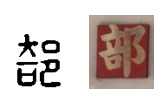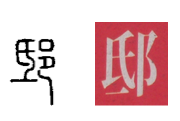163. The "Right Village" Radical: 阝
In some ways the 阝 radical looks very simple. You can draw it in just three strokes. (Well, some sources say that 阝 has just two strokes—one for the left side and one for the right. But others perceive the right side as requiring two strokes, and Joy o' Kanji takes that point of view.)
Anyway, "simple" here actually means "simplified," and there's a bit more complication behind the scenes.
In the past, these two shapes were radicals:
邑 (village), appearing on the right sides of characters
阜 (hill), appearing on the left sides of characters
Later, 阝 replaced both. It can appear on the left side of a character or on the right.
Note that the radical 阜/阝 means "hill," just as the autonomous Joyo kanji 阜 does.
Transforming 邑 Into 阝
Let's look at two examples of how 邑 turned into 阝. Here's 部 (384: section, part, category, division) in its past and present forms:

The image on the left, which is courtesy of Richard Sears, is an LST seal–script version of 部. The image on the right is from my photo of a large Chinese sign in Tahiti.
Similarly, 邸 (1613: stately residence, mansion) has changed as follows:

On the left we find a seal-script version of 邸, again courtesy of Richard Sears. The image on the right is again from my trip to Tahiti and is from a Japanese sign.
The Two Types of 阝
Should we consider阝to be one radical or two? That's in the eye of the beholder. Spahn and others treat 阝 as the same radical, no matter where it's located. By contrast, Nelson differentiates between the two types of 阝. Joy o' Kanji has followed Nelson's lead and makes the following distinctions:
radical 163: the "right village" radical, 阝, as in 都 (355: metropolis, capital)
radical 170: the "left hill" radical, 阝, as in 院 (229: institution)
Incidentally, when you use the radical look-up tool in Denshi Jisho, you'll see this choice in the array of radicals:

Clearly, Denshi Jisho does not treat them as identical.
Photo Credit: Eve Kushner
A restaurant named Miyako in Melbourne, Australia. "Miyako" is written as 都 (みやこ: metropolis, capital).
More Differentiation
Beyond the left and right versions of 阝, there's a bit more differentiating to do. This time the similarity is in the English name, not in the shape. That is, the word "village" pops up in another radical name:
radical 166: the "village" radical, 里
We find additional similarities in the yomi of these three radicals, as shown in red:
• radical 166, 里 (さと)
• radical 163, 邑/阝(おおざと and ゆう)
• radical 170, 阜/阝 (こざと, こざとへん, or おか)
Photo Credit: Eve Kushner
We see the "right village" radical in 郷 (841: hometown, native place), which has the kun-yomi of さと. This reading is non-Joyo, which must be why furigana appears in the sign. Although I've defined 郷 as "hometown, native place," we can interpret it as "village" in 杉ノ郷 (すぎのさと: Cedar Village). The katakana カントリークラブ means "country club," which often indicates a golf course.
Not a Variant
Some dictionaries treat the seven-stroke 邑 as a variant of 阝, but we won't. After all, radical variants need to pop up inside characters. For instance, the left side of 洋 (404: ocean, Western style) is a version of the "water" radical 水.
By contrast, 邑 no longer plays a part in any Joyo kanji, popping up only in uncommon characters such as the non-Joyo 郒, which is a variant of 郎 (1936: male name suffix). Thus, it wouldn't make sense for Joy o' Kanji to treat as a variant. When it comes to the Joyo set, its radical days are over!
Can You Spot the Village?
Despite all this variability, the meaning of "village" has mostly remained constant in Joyo kanji that have 阝 on the right. That is, the following kanji all involve boundary lines around the areas in which people live:
都 (355: metropolis, capital)
郡 (467: county; district; subprefecture)
郷 (841: hometown, native place)
郭 (1076: outer enclosure; outline; contour)
郊 (1254: outskirts; suburb)
After all, a village can be not just a collection of houses but also a subdivision in a metropolis.
We find a few more kanji whose meanings again have to do with subdividing space, but in a different sense:
部 (384: section, part, category, division)
邸 (1613: stately residence, mansion)
邦 (1792: country; Japanese, Japan)
Photo Credit:
Corey Linstrom
The last kanji, 邦 (1792), appears on this bottle of 泡盛 (あわもり: Okinawan shochu, a type of strong liquor). The label says 海乃邦 (うみのくに: sea country). This name probably refers to the way in which Okinawa lies in the middle of the sea. The middle kanji is non-Joyo.
Outliers
Finally, we come upon three Joyo kanji that seem to lie outside the lines I've just drawn in my own "districting" effort:
郵 (983: mail)
邪 (1340: evil, wicked, bad, unjust, wrong)
那 (2084: ナ sound)
That is, it's hard to spot a village in these characters. However, two of these kanji have villages tucked inside their etymologies.
Henshall says that 郵 originally depicted "village" combined with "billowing flag." The flag indicated a relay station on a messenger route. People wrote messages on the flag, so 郵 came to mean "communication" in general and then "mail."
Meanwhile, 邪 was originally the name of a particular village in ancient China, says Henshall.
Photo Credit: Eve Kushner
Sign for a post office (郵便局, ゆうびんきょく) on Sado Island. It serves the town of 小木 (おぎ) and the village of 宿根木 (しゅくねぎ).
It Takes a Village
Taking four of these "right village" kanji, we can make the following sentence:
京都郊外の郵便局で同郷人に巡り会いました。
At the post office in a Kyoto suburb, (I) happened to meet people from my hometown.
京都 (きょうと: Kyoto); 郊外 (こうがい: suburb); 郵便局 (ゆうびんきょく: post office); 同郷人 (どうきょうじん: people from one's hometown); 巡り会う (めぐりあう: to happen to meet)
To form this sentence, it truly takes a village—in fact four of them!
